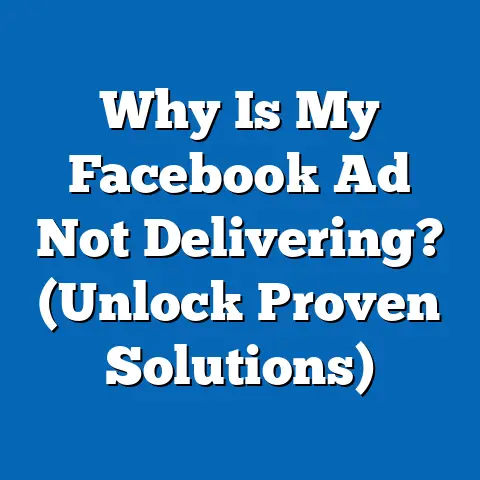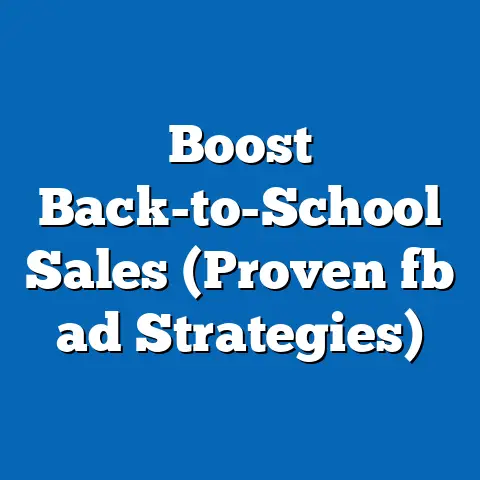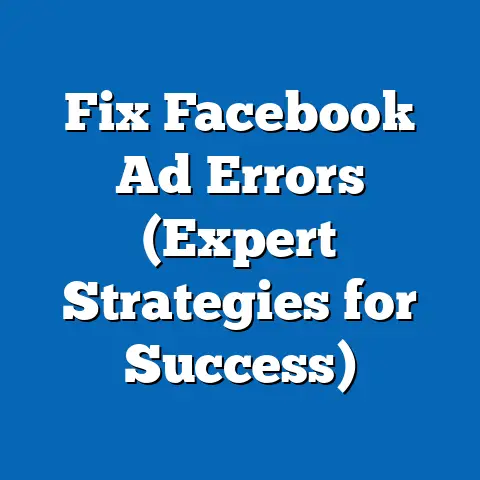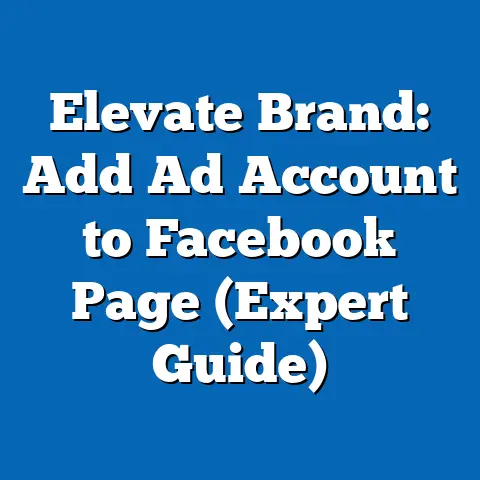Cutting Back on Facebook Ads (Strategic Cost-Saving Tips)
In an era where digital presence is often equated with business success, the idea of cutting back on Facebook ads seems counterintuitive, if not outright risky. After all, with over 2.9 billion monthly active users as of 2023 (Statista, 2023), Facebook remains a titan of social media advertising, offering unparalleled reach and targeting capabilities. Yet, many businesses—especially small to medium-sized enterprises (SMEs)—are finding that the escalating costs of advertising on the platform, combined with diminishing returns, are forcing a strategic rethink.
Why would companies step back from a platform that promises to connect them with a global audience at the click of a button? The answer lies in a complex interplay of rising ad costs, shifting user behaviors, and evolving digital marketing landscapes. This article delves into the strategic cost-saving tips for cutting back on Facebook ads, exploring the defining characteristics of this shift, the historical context of digital advertising, and the broader societal and economic implications of this trend.
Defining Characteristics of Cutting Back on Facebook Ads
Cutting back on Facebook ads does not necessarily mean abandoning the platform altogether. Instead, it reflects a deliberate recalibration of marketing budgets, often driven by the need to optimize return on investment (ROI) amid rising costs. According to a 2022 report by Hootsuite, the average cost-per-click (CPC) for Facebook ads has increased by 17% year-over-year, with costs in competitive industries like finance and technology often exceeding $3 per click.
This strategic reduction is characterized by several key approaches: diversifying ad spend across other platforms, focusing on organic content to build long-term audience engagement, leveraging data analytics to target high-value audiences more efficiently, and prioritizing cost-effective alternatives such as email marketing or influencer partnerships. Businesses are also becoming more selective, running shorter, more targeted campaigns rather than maintaining a constant ad presence.
Moreover, this shift often involves a deeper focus on understanding audience fatigue. With users increasingly bombarded by ads—Facebook users see an average of 12 ads per day (Social Media Today, 2022)—there’s a growing risk of ad blindness, where users scroll past promotions without engagement. Cutting back, therefore, becomes a way to maintain brand credibility by avoiding overexposure.
Historical Context: The Rise and Plateau of Facebook Advertising
To fully grasp why businesses are reevaluating their reliance on Facebook ads, it’s essential to understand the historical trajectory of the platform’s advertising model. Launched in 2004, Facebook initially focused on connecting users through a free, ad-light experience. By 2007, however, the platform introduced “Facebook Ads,” allowing businesses to target users based on demographics, interests, and behaviors—a revolutionary step that transformed digital marketing.
Throughout the 2010s, Facebook solidified its dominance as ad revenues skyrocketed, reaching $114.9 billion by 2021 (Meta, 2022). This growth was fueled by the platform’s ability to offer hyper-targeted advertising, bolstered by sophisticated algorithms and vast user data. Small businesses, in particular, benefited from relatively low entry costs, with ad campaigns starting at just a few dollars a day.
However, the landscape began to shift in the late 2010s. High-profile data privacy scandals, such as the 2018 Cambridge Analytica controversy, eroded user trust and led to stricter regulations like the European Union’s General Data Protection Regulation (GDPR). These changes, coupled with Apple’s 2021 iOS update limiting data tracking, reduced the effectiveness of Facebook’s ad targeting capabilities, driving up costs as businesses struggled to maintain previous performance levels.
Simultaneously, competition in the digital ad space intensified. Platforms like TikTok, with its 1.5 billion users (Statista, 2023), and Pinterest began siphoning ad dollars by offering innovative formats and younger, engaged audiences. For many businesses, the once-unquestionable value of Facebook ads started to plateau, prompting a reevaluation of spending strategies.
Societal Implications: A Shift in Digital Trust and Consumer Behavior
The move to cut back on Facebook ads carries broader societal implications, reflecting changing attitudes toward digital platforms and advertising. One significant factor is the growing skepticism among consumers about data privacy. A 2023 Pew Research Center survey found that 81% of Americans are concerned about how companies use their personal data, with many pointing to social media giants like Facebook as primary culprits.
This distrust has tangible effects on ad performance. Users are more likely to opt out of data tracking or use ad blockers, reducing the pool of reachable audiences. For businesses, this means higher costs to reach fewer people, further incentivizing a shift away from heavy reliance on paid ads.
Additionally, generational shifts in social media usage are reshaping advertising strategies. Gen Z, born between 1997 and 2012, increasingly favors platforms like TikTok and Instagram for entertainment and discovery, often viewing Facebook as outdated or irrelevant. A 2022 study by Morning Consult found that only 32% of Gen Z users regularly engage with Facebook, compared to 70% for Instagram. This migration forces businesses to rethink where their ad dollars are most effective, often leading to reduced Facebook budgets.
Culturally, the trend also reflects a broader push toward authenticity in marketing. Consumers, especially younger ones, crave genuine connections with brands rather than overt sales pitches. Overloading users with ads can backfire, creating perceptions of desperation or insincerity. By cutting back, businesses signal a willingness to prioritize value-driven engagement over aggressive promotion—a move that aligns with evolving societal expectations.
Strategic Cost-Saving Tips for Cutting Back on Facebook Ads
Given the challenges and changing dynamics, businesses must adopt strategic approaches to reduce reliance on Facebook ads without sacrificing visibility or growth. Below are detailed, actionable tips grounded in current trends and data.
1. Diversify Ad Spend Across Platforms
Rather than concentrating budgets on Facebook, businesses should explore other platforms that align with their target audience. TikTok, for instance, offers lower CPC rates in many markets—averaging $1.00 compared to Facebook’s $1.72 (Hootsuite, 2023)—and excels at viral, short-form content. LinkedIn, while more expensive, is ideal for B2B companies targeting professionals, with 80% of leads generated through the platform (LinkedIn Marketing Solutions, 2022).
Diversification mitigates risk by preventing over-dependence on a single channel. It also allows businesses to test and compare performance metrics across platforms, optimizing spend based on real-time results.
2. Invest in Organic Content and Community Building
Organic content—posts, stories, and interactions that don’t require payment—remains a powerful tool for building brand loyalty. While Facebook’s algorithm often prioritizes paid content, consistent, high-quality organic posts can still drive engagement. For example, a 2022 study by Sprout Social found that brands posting authentic, value-driven content (e.g., behind-the-scenes looks or user testimonials) saw 33% higher engagement rates than purely promotional posts.
Community building, such as creating or engaging in Facebook Groups, also offers a cost-effective way to maintain visibility. These spaces foster direct interaction with customers, reducing the need for paid reach.
3. Leverage Advanced Analytics for Hyper-Targeted Campaigns
Rather than broad, continuous ad campaigns, businesses should use Facebook’s robust analytics tools to identify and target high-value audiences. Lookalike Audiences, for instance, allow advertisers to reach users similar to their best customers, often at a lower cost per conversion. A 2021 case study by Meta showed that businesses using Lookalike Audiences saw a 20% increase in ROI compared to standard demographic targeting.
Additionally, focusing on retargeting—showing ads to users who’ve already interacted with your brand—can maximize efficiency. Retargeting campaigns typically have a 10x higher click-through rate than display ads (AdRoll, 2022), making them a smarter use of limited budgets.
4. Explore Cost-Effective Alternatives
Email marketing remains one of the most cost-effective channels, with an average ROI of $42 for every $1 spent (Litmus, 2023). Building a robust email list allows businesses to nurture leads without recurring ad costs. Similarly, influencer partnerships—especially with micro-influencers (10,000–50,000 followers)—can provide authentic promotion at a fraction of traditional ad spend, with 82% of consumers trusting influencer recommendations (Nielsen, 2022).
Content marketing, such as blogging or video tutorials, also offers long-term value. Unlike ads, which stop delivering once the budget runs out, evergreen content continues to attract traffic and leads over time.
5. Optimize Ad Creative and Timing
If maintaining some level of Facebook ad spend is necessary, focus on optimizing creative elements and scheduling. A/B testing different ad formats—images, videos, carousels—can reveal what resonates most with your audience, reducing wasted spend. Videos, for instance, have a 6% higher engagement rate on average than static images (Social Insider, 2023).
Timing is equally critical. Running ads during off-peak hours or days can lower CPC due to reduced competition. Tools like Facebook Ads Manager provide insights into when your audience is most active, allowing for precise scheduling.
6. Set Clear Budget Caps and Performance Goals
To avoid overspending, establish strict daily or campaign budget caps within Facebook Ads Manager. Pair this with clear key performance indicators (KPIs), such as cost-per-acquisition (CPA) or return on ad spend (ROAS). If a campaign consistently underperforms—e.g., ROAS falls below 2:1—pause it immediately and redirect funds to higher-performing channels.
Regularly reviewing ad performance ensures that budgets are allocated only to strategies delivering measurable results. This disciplined approach is particularly crucial for SMEs with limited marketing resources.
Economic and Workplace Implications
Economically, cutting back on Facebook ads can have a ripple effect across industries. For small businesses, reallocating budgets to more affordable channels or organic growth strategies can preserve cash flow, allowing investment in product development or customer service. However, this shift may challenge digital marketing agencies that rely heavily on managing large Facebook ad campaigns, potentially leading to layoffs or a pivot to other services.
In the workplace, this trend underscores the need for upskilling in diverse digital marketing tactics. Marketers must become proficient in analytics, content creation, and cross-platform strategies to remain competitive. Companies may also need to hire or train staff in emerging areas like TikTok advertising or SEO, reflecting a broader evolution in job roles within the marketing sector.
Technological Factors Driving the Shift
Technological changes are at the heart of why cutting back on Facebook ads has become a viable strategy. The aforementioned iOS 14.5 update, which introduced App Tracking Transparency (ATT), significantly reduced Facebook’s ability to track user behavior across apps, impacting ad personalization. Meta reported a $10 billion revenue loss in 2022 due to these changes (Meta, 2022), with much of the burden passed on to advertisers through higher costs.
Meanwhile, advancements in AI-driven analytics tools allow businesses to better understand customer behavior without relying on platform-specific data. Tools like Google Analytics 4 or third-party CRM systems provide actionable insights, empowering companies to make informed decisions about where to allocate marketing dollars.
Cultural Nuances and Diversity in Approach
It’s important to acknowledge that not all businesses or industries will approach cutting back on Facebook ads in the same way. For instance, e-commerce brands targeting older demographics (e.g., Baby Boomers or Gen X) may still find Facebook indispensable, as 66% of users aged 50+ are active on the platform daily (Pew Research Center, 2023). Conversely, fashion or lifestyle brands targeting Gen Z may see better results on Instagram or TikTok, where visual storytelling dominates.
Geographic and cultural differences also play a role. In regions like Southeast Asia, where Facebook remains a primary internet portal for millions, reducing ad spend might be less feasible. A nuanced strategy, tailored to specific markets and audience segments, is essential to avoid alienating key customer bases.
Forward-Looking Insights and Uncertainties
Looking ahead, the trend of cutting back on Facebook ads is likely to persist as businesses seek sustainable, cost-effective marketing solutions. Emerging technologies, such as augmented reality (AR) ads or Web3 platforms, may further disrupt traditional social media advertising, offering new avenues for engagement. However, these innovations come with their own learning curves and cost considerations, creating uncertainty about their long-term viability.
Regulatory pressures around data privacy are also expected to intensify, potentially further limiting the effectiveness of platforms like Facebook. Businesses must stay agile, continuously evaluating the digital landscape to identify where their audiences are moving and how best to connect with them.
Moreover, the pendulum may swing back if Meta adapts by lowering ad costs or introducing more advertiser-friendly features. The company’s ongoing investments in the metaverse and AI suggest a potential reinvention of its advertising model, which could reshape the cost-benefit equation for businesses.
Conclusion
The paradox of cutting back on Facebook ads in a hyper-digital world reflects a broader reckoning with the costs and benefits of social media advertising. While the platform remains a powerful tool, rising expenses, shifting user behaviors, and technological disruptions are prompting businesses to adopt strategic cost-saving measures. From diversifying ad spend to prioritizing organic engagement and leveraging analytics, these approaches offer a path to sustainable growth without sacrificing visibility.
The societal implications—ranging from evolving consumer trust to generational platform preferences—highlight the complexity of this shift, while economic and workplace impacts underscore its far-reaching consequences. As the digital marketing landscape continues to evolve, businesses must remain adaptable, balancing innovation with pragmatism. While the future of Facebook advertising is uncertain, one thing is clear: strategic cost management is not just a trend but a necessity in navigating the challenges and opportunities of the digital age.




